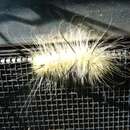Conservation Status
provided by University of Alberta Museums
Widespread but uncommon here at the northwestern edge of it's range.
- license
- cc-by-nc
- copyright
- University of Alberta Museums
Cyclicity
provided by University of Alberta Museums
Adults have been collected in Alberta from late June through mid-July.
- license
- cc-by-nc
- copyright
- University of Alberta Museums
Distribution
provided by University of Alberta Museums
A species of the eastern hardwood forest, recorded west to southeastern Alberta, and south to UT, CO, TX, KS and GA. In Alberta, it has been collected mainly in the eastern aspen parklands and grasslands regions, north to Lloydminster. Reports of American dagger moths from further west in Alberta (Peace River and foothills regions) in Prentice (1962) are questionable and need verification.
- license
- cc-by-nc
- copyright
- University of Alberta Museums
General Description
provided by University of Alberta Museums
A fairly large (5.0 - 6.2 cm wingspan) brownish grey moth with darker markings. The forewings are grey with darker lines and spots, and with the veins lightly lined with dark scales. The postmedian line is doubled and the interspace is white, forming a contrasting toothed band. The hindwing is pale grey-brown with a faint darker median line and veins in the male. The female is similar but darker, especially the hindwings which are sooty brown. The antennae of both sexes are simple. A. dactylina is similar, but is lighter powdery grey, with fewer markings and in particular lacking the doubled, white-filled postmedian band on the forewing, the median line on the hindwings, and the dark scales along the veins.
- license
- cc-by-nc
- copyright
- University of Alberta Museums
Habitat
provided by University of Alberta Museums
Deciduous woodlands, shelterbelts and urban plantations.
- license
- cc-by-nc
- copyright
- University of Alberta Museums
Life Cycle
provided by University of Alberta Museums
"The larvae are solitary defoliators on various deciduous trees, in particular maple and birch. They are covered in long white or pale yellow hairs, with several tufts of longer, black hairs. There is a single brood each year, which overwinter as pupae. They are never common enough in Alberta to be considered a pest. Most likely to be found associated with urban and shelterbelt plantings of Manitoba maple. The adults are usually attracted to light.
The American Dagger-moth is primarily a species of the eastern hardwood forests. The southern ssp. eldora is paler with crisper markings and Alberta specimens from Medicine Hat have been assigned to this form by Bowman (1951). Bowman also listed May as the adult flight period, apparently in error as all specimens in his collection are labeled as collected in June-July."
- license
- cc-by-nc
- copyright
- University of Alberta Museums
Trophic Strategy
provided by University of Alberta Museums
In Alberta larvae have been collected on Manitoba maple (Acer negundo). other trees have also been reported as hosts elsewhere (see Rings et al. 1992 and Prentice 1962).
- license
- cc-by-nc
- copyright
- University of Alberta Museums
Acronicta americana
provided by wikipedia EN
Acronicta americana, the American dagger moth, is a moth of the family Noctuidae. It was originally described by Thaddeus William Harris in 1841 and is native to North America.
Description
The American dagger moth has a wingspan of 50 to 65 mm (2.0 to 2.6 in) It usually has a sharp, double postmedian line, with white in between the two lines.[1] There is a black dash on the anal area of the forewing. The hindwing is gray with a faint, darker gray median line in the male.[1] The female is similar, except the hindwing is completely dark.
Subspecies
- Acronicta americana americana
- Acronicta americana obscura
- Acronicta americana eldora
Distribution
The American dagger moth is found in North America east of the Rocky Mountains.[2]
Flight period
The American dagger moth can be seen from April to September throughout its range.[1] Caterpillars can be seen from July to October. It has one brood in the north and two to three broods in the south.[3]
Habitat
The American dagger moth is found in deciduous woodlands and forests.[3]
Life cycle
The young caterpillar is densely covered with yellow setae. The older caterpillar's setae are either pale yellow or white. All instars have thin, black setae on the first and third abdominal segments. On the eighth abdominal segment, there is one tuft of black setae. The caterpillar will reach a length of 50 mm (2.0 in).[3] While there are numerous reports of the larval hairs of this species sometimes causing skin irritation in humans, there is no evidence that they possess any form of venom.[4]
Host plants
References
-
^ a b c Covell Jr, Charles V. (2005) [First published 1984]. Moths of Eastern North America. Martinsville, VA: Virginia Museum of Natural History. p. 82. ISBN 1-884549-21-7.
-
^ Bartlett, Troy; et al. (February 16, 2004). "Species Acronicta americana - American Dagger Moth". BugGuide. Retrieved August 12, 2010.
-
^ a b c Wagner, David L. (2005). Caterpillars of Eastern North America. Princeton, NJ: Princeton University Press. p. 324. ISBN 0-691-12144-3.
-
^ Wagner, David L.; Schweitzer, Dale F.; Sullivan, J. Bolling & Reardon, Richard C. (2011). Owlet Caterpillars of Eastern North America. Princeton University Press. ISBN 978-069115042-0.

- license
- cc-by-sa-3.0
- copyright
- Wikipedia authors and editors
Acronicta americana: Brief Summary
provided by wikipedia EN
Acronicta americana, the American dagger moth, is a moth of the family Noctuidae. It was originally described by Thaddeus William Harris in 1841 and is native to North America.
- license
- cc-by-sa-3.0
- copyright
- Wikipedia authors and editors

